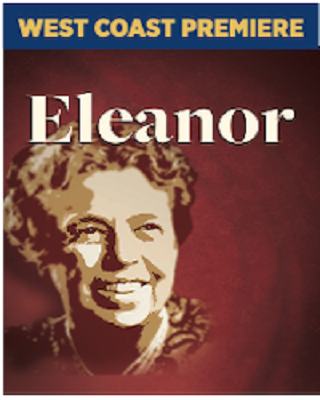By TR Robertson Photos by Aaron Rumley
It has been six years since Kandis Chappell last performed on stage and she has never performed a one-person show, but did she ever pick the perfect show to return to the stage. Kandis is currently on stage at Solana Beach’s North Coast Repertory Theatre in Mark St. Germain’s one-person play, “Eleanor”, marking the plays West Coast Premiere. If the immediate standing ovation at the end of the opening night performance is any indication of the performance she brings to the stage, then you are in for a tremendous theatrical experience as Kandis “brings to life” the person considered to be America’s Greatest First Lady. Eleanor Roosevelt.
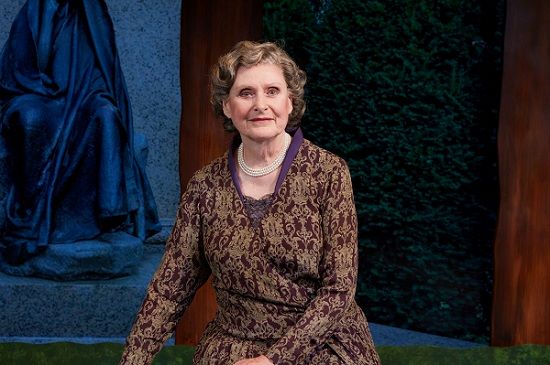
Kandis Chappell has appeared on Broadway, at the Lincoln Center, at the South Coast Rep in Costa Mesa, in over 30 productions at the Old Globe and in several productions at North Coast Repertory Theatre. She did extensive studies into the mannerisms, voice and history of Eleanor and her relationships as well as visiting several of the homes of Eleanor and the Roosevelts. All of this has led to an amazing portrayal of a fascinating and complicated woman. Eleanor Roosevelt is ranked 9th in the top 10 in Gallup’s List of Most Widely Admired People of the 20th Century and considered by most people to be America’s Greatest First Ladies.
The play takes place in Rock Creek Cemetery, Washington, D.C., at a favorite park bench Eleanor used to sit on in front of a statue by Augustus Saint-Gaudens, called “The Mystery of the Hereafter”, known as “Grief,” by most who are familiar with the statue. It was built by Saint-Gaudens as a memorial to his wife, Clover, who committed suicide. Eleanor loved the solitude she felt here where she could sit and reflect on her life and the people in her life. North Coast Rep Artistic Director and Director of “Eleanor” David Ellenstein and Set Designer Marty Burnett have designed a beautiful set around the bench, featuring artistic trees with panels lit between the branches. Three large panels between the trucks change from pictures of vegetation to show pictures of numerous people who played significant roles in the life of Eleanor and Franklin or major occurrences during their lives, handled by Sound and Projection designer Aaron Rumley.
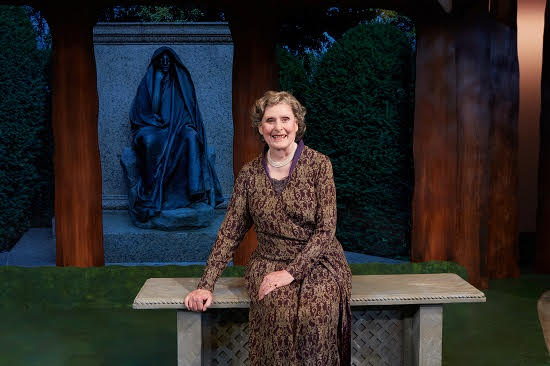
Kandis, as Eleanor, brings wit, humor, humanity and dignity to the longest serving first lady in American history. Eleanor was a political figure, an activist, a pacifist, a diplomat, and a humanitarian. She held no punches and was not afraid to take a stand for what she believed. Politically she was “thrown” into the position of First Lady with her husband’s election to President and made the decision that as long as she was First Lady, she was going to make a difference. Eleanor would take her position and expand what she saw as the duties and obligations of the position, and she would bring in her own ideas and goals.
This one-and-a-half-hour play is as much a history lesson as it is a look into the very complicated personal life of America’s 32nd and longest serving President and his wife Eleanor, the longest serving First Lady. The play opens with Eleanor telling us it is not unusual that she had a favorite park bench in a cemetery if you simply look on the cemetery as a “park with permanent residents”. She reminds us that she and FDR were married for 40 years and that although they were cousins, they were 5th cousins once removed. She also tells us that she and FDR lead separate lives and slept in separate bedrooms. The “whys” of this are explained later in the play.
Eleanor tells the audience about her mother who died when she was young from diphtheria and about her father who she loved dearly. Her father was an alcoholic who was committed to a sanitarium but suffered from deliriums that lead him to jump from a window, surviving but suffering from seizures that would eventually lead to his death. She was then raised by her maternal grandmother. Growing up, Eleanor saw herself as an “ugly duckling” and very plain. She could not believe Franklin would take an interest in her during their college years. One major conflict that will appear again and again is the fact that FDR’s mother, Sara, did not like Eleanor, never wanted FDR to marry her and attempted numerous things to get FDR to not marry her. They married despite this in New York City with President Theodore Roosevelt giving the bride away. Eleanor and Franklin would honeymoon for three months in Europe.
The Roosevelts had six children, one died in the first year. Eleanor did not consider herself a good mother. In 1918, Eleanor found letters written by her personal secretary Lucy Mercer, written to Franklin. She told Franklin she wanted a divorce, but Sara intervened and told Franklin if he divorced her, she would disinherit him. The couple remained together, but the marriage was never the same, becoming more of a political partnership. It is also thought that FDR had an affair with his private secretary Marguerite “Missy” LeHand, a woman who many thought was his Chief of Staff. If she was, she is the only woman to have held this position for a President.
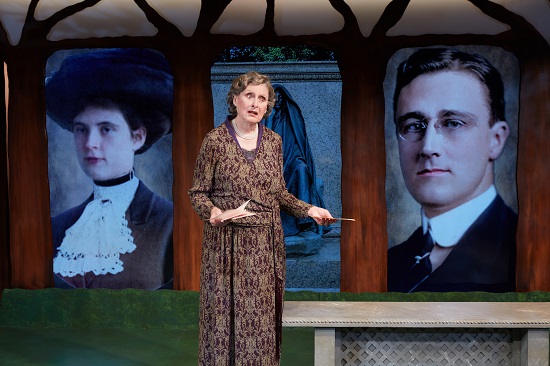
The play goes into the various political offices Franklin ran for, people that were important during this time and the disease he became inflicted with. Eleanor nursed him through the illness and refused to let him quit politics because of the illness, thought to be polio. A reporter, Louis McHenry Howe, would become an important member of FDR’s group, eventually becoming his political advisor and campaign manager. She and Louis would shelter FDR from reporters and hide him from having pictures taken that would reflect his illness.
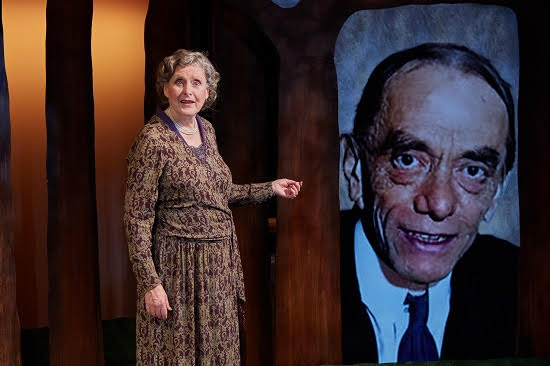
The play continues going through FDR dealing with the Great Depression, J. Edgar Hoover’s dislike of the Roosevelts (especially Eleanor, he kept a 3,000 page file on her), touches briefly on Eleanor’s relationship with an American journalist Lorena Hickman (some 3,500 letters exchanged between them), rumors of Eleanor having an affair with her former bodyguard Earl Miller and her involvement with helping out in a variety of ways during World War II and a funny story about Winston Churchill. Eleanor traveled to 17 islands in two weeks visiting the G.I.’s involved in the Pacific action of WW II. She mentioned that she and FDR would have dinner table disagreements over the handling of Jewish immigrant children, racial tension in the states, black service positions in the military and Japanese internment camps in the United States. The KKK was rumored to have put out a $25,000 bounty on Eleanor.
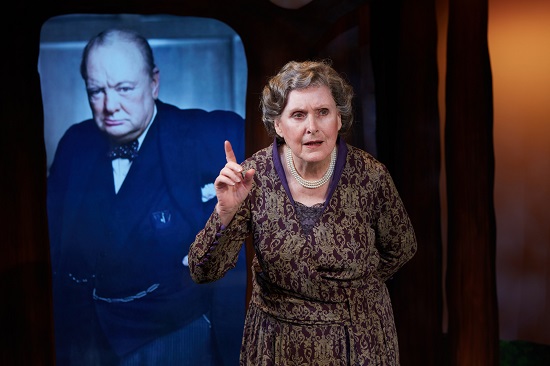
Kandis Chappell, as Eleanor, presented the death of Franklin as a woman who had lost someone she had once loved deeply, but finding out that Lucy, who Franklin had an affair with much earlier and had sworn to never see again, was at his side in Warms Springs, Georgia, at the Little White House, when he died. This was extremely hurtful to her. Eleanor was giving a speech when FDR died from a cerebral hemorrhage.
We learn that Eleanor was extremely active after FDR’s death. She would become a delegate to the U.N., champion the Peace Corps, work with the League of Women Voters, the National Urban League, advocate for expanding roles for women in the workplace, work for civil rights for African and Asian Americans and fight for rights for G.I.’s returning home from WW II. In the U.N. she was the Chair of the U.N. Human Rights Commission and would help pass the Universal Declaration of Human Rights. She did say that her marriage to FDR had helped her to accomplish “great things together you could never do alone”.
Eleanor contracted tuberculosis later in life and died from cardiac failure on November 7, 1962, at the age of 78, having lived 17 years after the death of FDR. President Truman had called her the “First Lady of the World”. President Kennedy ordered all flags to be lowered in tribute to Eleanor.
This tremendous, informative, wonderfully acted performance of “Eleanor”, will run at North Coast Rep until July 9. Tickets are available by calling 858-481-1955 or go to www.northcoastrep.org.
“Do what you feel in your heart to be right for you’ll be criticized anyway. You’ll be damned if you do and damned if you don’t.” Eleanor Roosevelt


